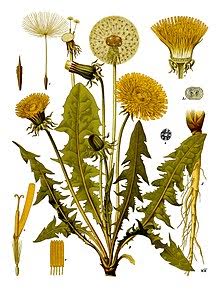As a kid I used to wander the empty fields of my south Florida neighborhood, the bible according to Euell Gibbons in hand. His book, Stalking the Wild Asparagus, was my first field guide to a life-long love of foraging.
The native flora of southern Ohio offers plenty of edibles, such as wild ramps, a delicacy similar to leeks, pawpaws, spicebush berries, and fiddleheads of ferns. But I’ve made an ethical choice not to harvest plants from the delicate forest understory. Too much of the land has been trampled and intruded upon by us humans, and I’d rather turn to less imperiled areas already disturbed by human activity. (I’ll make an exception for fruits, since that doesn’t remove the whole plant: if I can do so without causing damage, I’ll harvest things like pawpaws or wild plums.) In short, I choose to eat weeds. There’s a botanical name for these plants: ruderals. The label refers to hardy species able to colonize disturbed ground – whether farmed fields or “waste” places. Many of the ruderals were introduced by immigrants over the centuries, who brought with them plants from their Old World homes.
Whether maligned for growing as weeds in cultivated fields, or simply overlooked because they grow in vacant spaces, the following plants are abundant enough to provide staple greens throughout the growing season, and provide ample nutrition for anyone with the time to harvest. They are there for the taking, freeing you from the time needed for sowing and thinning and weeding the more familiar garden greens. The following handful of species can serve as a practical foundation and an easy entry to foraging for wild foods. A simple Internet search will turn up loads of information; here I’ll give a brief intro to each.
Dandelion, Taraxacum officinale
Dandelion, Taraxacum officinale, superhero of the weed world, starts off the growing season. The presence of “officinalis” or “officinale” in its Latin species name attests to its long standing value in the European apothecary. The too-often maligned dandelion is considered by some a superfood, with very high levels of vitamin A, as well as a great source of vitamin C, folate, beta-carotene, antioxidants and minerals. As one of the first plants brought to the New World by Eurpoeans, iIt should be a staple in everyone’s diet. Leaves can be harvested early in the season when they are small, as bitterness increase quickly as the plants grow. You can blanch the leaves by covering plants with a layer of mulch or cardboard, or an overturned bucket. And the flowers make a delicious veggie burger, where flour and egg help to bind the bulk of yellow flowers together. I make a batch or two in the spring and store in the freezer, then pan fry throughout the year.
Chickweed, Stellaria media,
Another late winter/early spring offering to look forward to is Chickweed, Stellaria media, an introduced species that grows in clumps just about everywhere its seeds fall. I've seen it growing around telephone poles, along houses, and it can carpet the ground in my garden. This plant is one of the earliest to appear at the end of winter, and eaten raw it is a restorative shot of chlorophyll after a long winter. You can mix it into salads, or lightly steam it, or put it through the juicer. It has a somewhat grassy taste to my palate, so I prefer it mixed with other raw greens. Like dandelion this plant has medicinal uses as well. It’s valued as a part of Japan’s traditional Festival of Seven Herbs, celebrated on January 7.
A bit later in the season the following three plants appear and their greens will be available until the end of the growing season.
Redroot pigweed, Amaranthus retroflexus
Redroot pigweed, Amaranthus retroflexus, is one of the many species of wild amaranth native in the Americas. Though native, it was not so commonly found until agriculture spread across North America, as it loves to grow in disturbed fields. Agricultural extension offices consider this plant a noxious weed. Its unfortunate name masks the fact of its high nutritional value and excellent flavor. I remember a Jamaican neighbor dancing with delight when she learned of this plant growing in my garden. She said it was the veggie used to make the traditional Jamaican dish, calaloo. I provided her with bags of it. It can be used as a substitute for spinach in any dish, and, like spinach, pigweed has oxalic acid in its leaves and should be cooked. Imagine if instead of trying to eradicate pigweed in favor of their cultivated crop, the farmers harvested it for market! It cooks up like spinach, becoming tender within a few minutes. I call this summer spinach because it’s super available when cool-weather-loving spinach’s growing season has ended.
Purslane, Portulaca oleracea
Another plant that’s easily found and easily established in one’s garden is Purslane, Portulaca oleracea - a low creeping, shallow-rooted succulent that will reseed itself from year to year. This native to the Mediterranean regions is in the cuisines as widespread as Turkey, Russia, India, north Africa, Mediterranean Europe, Mexico. The fleshy leaves and stems are excellent either raw or cooked. In addition to its high levels of vitamin C and minerals, it has high amounts of essential fatty acids and antioxidants. I like to munch on freshly picked purslane while working in the garden, and it’s also great sautéed and pickled. A Google search will produce numerous international recipes for preparing it.
Lambs quarter, Chenopodium album
Last but far from least is Lambs quarter, Chenopodium album. This highly adaptable ruderal is thought to have been native to Europe but is now naturalized globally and valued. It’s related to spinach and beets and can be used as a spinach substitute. The leaves are more substantial than those of pigweed, so they're appealing to munch on raw. But they cook up quickly to a spinach-like texture and are excellent just steamed with a bit of butter. They make a great spinach substitute in a Korean spinach salad, a fabulous Indian saag, and a delectable spanakopita. The best thing about Lambs quarter is that it provides a generous ongoing harvest of leaves throughout the season. While most gardeners have to coddle their spinach, and then enjoy only while temperatures remain cool, lambs quarter is readily available with no fuss. In fact, I don’t bother to grow or purchase spinach knowing that I can depend upon this plant reseeding itself annually in my yard and garden beds.
An easy way to guarantee a supply of these foods is to get some seed and establish them around your yard. Dedicate some space for weeds, and you’ll have an easy supply of greens most of the year. Once established, they’ll return reliably year after year.
A good resource to learn more:
The Wander School by Abby Artemisia
thewanderschool.com
Wildcrafting, Wild Foods, Asheville, Celo, Burnsville, Edible Food, Medicinal Plants, Botany, Plant Walks, Abby Artemisia
Karen Arnett is a former freight pilot and weather forecaster who loves to observe the natural world. She is a beekeeper and gardener and besides helping with the CORV Guide, she’s on the planning team for the Midwest Native Plant Society’s annual conference. She also helps plant trees in her community.







